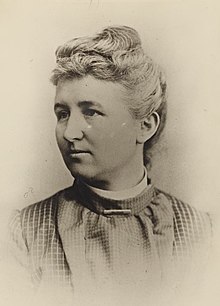Clarissa Dixon
Clarissa Dixon | |
|---|---|
 Portrait of Dixon c. 1910 | |
| Born | November 30, 1851 Hennepin, Illinois, U.S. |
| Died | May 15, 1916 (aged 64) Menlo Park, California, U.S. |
| Occupation |
|
| Notable works | Janet and Her Dear Phoebe (1909) |
| Children | 2 (including Henry Cowell) |
Clarissa Belnap Dixon[a][b] (born Clara Belnap Dixon; November 30, 1851 – May 15, 1916) was an American bohemian, anarchist philosopher, labor activist, feminist and poet who lived at various times in Iowa, New York City, Kansas, and California. She was the mother of avant-garde composer Henry Cowell.
| Part of a series on |
| Anarchist communism |
|---|
 |
| Part of a series on |
| Anarchism |
|---|
 |
Early life
Childhood
Clara Belnap Dixon was born on November 30, 1851, in Hennepin, Illinois, a small town on the Illinois River about forty miles north of Bloomington, to woodworker Samuel Asenath Dixon and Bethshua Dixon (née Nash).[1] The family's ancestry was of mostly Scotch and Irish descent, but Samuel's lineage was partially English and had been in America for centuries, with figures including astronomer Jeremiah Dixon, one of the surveyors behind the American Mason–Dixon line.[2]
Clarissa was the second of five children born to Samuel and Bethshua. The family moved at some point, to let all the children to attend free public school and church in the small village of Amityville, near
Frustrated by her parents' beliefs, she left the town at age seventeen and relocated to the nearby city of
Early activism
As a young woman, Clarissa regularly attended
As early as 1883, Dixon's politically charged essays and manifestos were attracting both praise and scorn from around the country. She was being solicited by papers and magazines from the nation's largest cities, though her popularity mainly rest among the more impoverished communities of the northern Midwest.[5]
Settling in California
Burgeoning career
Urging to escape the Midwest and its fundamentalist atmosphere, she took the train alone to San Francisco in 1890, a city with a then-lively colony of unconventional writers. Clarissa, it has been suggested, may have been specifically drawn to the bohemianism of the literary community, but it's unknown precisely which aspects of the city and California more broadly appealed to her.[4] From 1889 to 1891 she was the assistant editor of an anarchist weekly, The Beacon. Dixon's friendships during this period included the writers Jack London, George Sterling and Ambrose Bierce.[6][7]
While in San Francisco, she teamed up with a young Irish immigrant, Harry Cowell, to found the fortnightly anarchist paper, Enfant Terrible. As well as in a 1892 article from the New York journal Liberty: The State uses money robbed from the parents to perpetuate its powers of robbery by instructing their children in its own interest. The church also, uses its power to perpetuate its power. And to these twin leeches... are the tender minds of babies entrusted for education.[8][9]
She released her only published book in 1909, the LGBT feminist novel Janet and Her Dear Phebe, which The New York Times characterized at the time as, "a very intense sort of a love story in which the lovers are two little girls who are devoted to each other with that fervency known only to feminine childhood".[10]
Dixon and Cowell would marry in 1893.
Later life
Raising Henry
Dixon's second child, Henry Dixon Cowell, was born in 1896, at which point she was forty-six years old.[11][12][13] In 1914, Dixon began a typescript manuscript of biographical details of her son's early life,[14] which she completed before her death from breast cancer in 1916, at age 64.[1]
Footnotes
References
Citations
- ^ a b Clarissa Dixon in the California, U.S., Death Index, 1905–1939, ancestry.com. Retrieved 13 April 2022.
- ^ Sachs (2012), p. 11.
- ^ a b c Sachs (2012), p. 12.
- ^ a b Sachs (2012), p. 13.
- ^ a b c Sachs (2012), p. 14.
- ^ Sachs (2012), p. 16.
- ^ Rich, Alan (2008) American Pioneers: Ives to Cage and Beyond
- ^ Sachs (2012), p. 15.
- ^ Dixon, Clarissa (1892). "Relations Between Parents and Children", Liberty.
- ^ "New York Times (1857–1922), Saturday Review of Books, Loves of Little Girls". New York Times. March 13, 1909. p. 141.
- ^ Hicks (2002), p. 15.
- ^ Tommasini, Anthony (1997), "Modern Times Catch Up to a Past Maverick", The New York Times, Retrieved 23 June 2022.
- ^ Sachs (2012), p. 14-15.
- .
Sources
- Hicks, Michael (2002). Henry Cowell, bohemian. Urbana: University of Illinois Press. ISBN 0-252-02751-5.
- Sachs, Joel (2012). Henry Cowell: A Man Made of Music. Oxford: Oxford University Press. ISBN 978-0-19-510895-8.
- Dixon, Clarissa Belnap (1909). Janet and Her Dear Phebe. Frederick A. Stokes.

